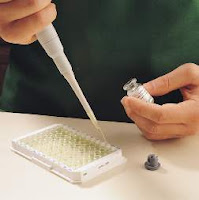Specific diagnosis of norovirus is routinely made by polymerase chain reaction (PCR) assays or real-time PCR assays, which give results within a few hours. These assays are very sensitive and can detect concentrations as low as 10 virus particles.
Tests such as ELISA that use antibodies against a mixture of norovirus strains are available commercially but lack specificity and sensitivity.
Norovirus infection is often diagnosed based on the combination of symptoms, particularly violent vomiting, cramps, and low-grade fever. No specific treatment is available and you will usually not need to visit a doctor. Instead:
- Stay at home.
- Take paracetamol to relieve symptoms of any fever.
- Drink plenty of water to replace the fluids lost through diarrhoea and vomiting. This prevents dehydration.
Drinking plenty of fluids is particularly important for young children and the elderly, who are more prone to dehydration. Try to eat a light diet of foods that are easy to digest, such as soup, rice, pasta and bread. Babies should be given their normal feed throughout.
To reduce the risk of passing the virus onto others, wash your hands regularly and stay at home until you are clear of symptoms for 48 hours. If your symptoms continue for more than three days or you feel severely dehydrated, seek medical attention immediately.
Dehydration
If you are finding it hard to keep down fluids, try to take small sips more frequently to keep yourself hydrated.
Rehydration solution
If you are dehydrated, you will have lost sugars and salts from your body as well as fluids. Rehydration solution can help replace all the minerals you have lost and re-establish a balance of fluids in your body. Solutions usually come in a powder form that you mix with water and drink. These are available from pharmacies, so ask your pharmacist or GP for advice.
Severe dehydration
If you are severely dehydrated, you may need to go into hospital. Fluids can be given directly into your body by a naso-gastric tube (up the nose) or a saline drip (into a vein).



 Posted in:
Posted in: 


1 comentarios:
Your informational post is great resource for lot of peoples and i got the good knowledge to read your informational post.
Diagnosis treatment
Post a Comment